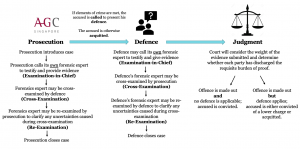CJC-F, CJC-F Announcements, CJC-F Understanding Forensics
Forensics in a Criminal Trial
Introduction
Even though forensic evidence plays a critical role in a criminal trial, it often does not receive the credit it deserves. In the course of a criminal trial, lawyers (both the prosecution and defence) may rely on various forensic evidence (e.g. bloodstain, DNA traces and fingerprint) to aid their case.
Generally, forensic evidence is gathered at a crime scene by crime officers from the Police before being sent to the Health Sciences Authority (“HSA”) for analysis. The evidence is analysed by a forensic expert, who may be summoned by the prosecution to give evidence and be cross-examined at trial. The defence may also call their own expert to testify and provide evidence. The court will then assess the weight of the forensic evidence in determining whether either party has discharged its requisite burden of proof.
From Crime Scene to Court
 Even though police officers are generally in charge of a crime scene, the circumstances of the case may require the advice of forensic scientists and pathologists. These experts provide professional advice as to how the crime scene should be preserved and how the evidence should be collected in the most optimal manner.
Even though police officers are generally in charge of a crime scene, the circumstances of the case may require the advice of forensic scientists and pathologists. These experts provide professional advice as to how the crime scene should be preserved and how the evidence should be collected in the most optimal manner.
 Even though police officers are generally in charge of a crime scene, the circumstances of the case may require the advice of forensic scientists and pathologists. These experts provide professional advice as to how the crime scene should be preserved and how the evidence should be collected in the most optimal manner.
Even though police officers are generally in charge of a crime scene, the circumstances of the case may require the advice of forensic scientists and pathologists. These experts provide professional advice as to how the crime scene should be preserved and how the evidence should be collected in the most optimal manner.The evidence is then gathered, preserved, and sent to the HSA for further analysis. For cybercrimes, evidence is analysed by the Criminal Investigation Department (“CID”), which has its own cybercrime division.
Once the evidence has been analysed, the relevant reports are compiled before being submitted to law enforcement agencies (and subsequently the prosecution). The prosecution will consider the evidence as well as the public interest before working with the police to decide on the charges to bring against the accused.
Once the accused has been charged with a crime, the case is then subjected to disclosure. At the Criminal Case Disclosure Conference (Committal Hearing for High Court cases), the prosecution will provide copies of the forensics reports it intends to introduce at trial.
Material forensic evidence in the defence’s favour is also made known to them. This provides “greater transparency and parity between the parties” (Li Weiming v PP at ), ensuring a fair trial for the accused.
Trial – Burden of Proof

Unlike in civil law where both parties in dispute are required to prove their case on a balance of probabilities, criminal law imposes a different burden of proof on the prosecution and the defence. The prosecution is required to prove their case beyond a reasonable doubt while the defence is required to prove theirs on a balance of probabilities.
Why is there a different standard of proof imposed in criminal law cases?
Where a person is convicted of a crime, the penal sanctions that can be imposed are serious (e.g death penalty, imprisonment). As the punishments imposed have a severe impact on the life and liberty of the individual, the standard of proof placed on the prosecution is thus very much higher (i.e beyond a reasonable doubt).
Trial – Trial Process
The procedure at trials in all courts is codified in the Criminal Procedure Code Part XII at section 230. The flow chart below illustrates the criminal trial process.

Fun Fact! Do you know that after the prosecutor has concluded his case, the defence may invite the court to dismiss the case on the ground that there is no case to answer? Since the prosecution is required to prove their case beyond reasonable doubt, the defence may cast doubt on the prosecution’s case and the prosecution will be required to reply to the submission. The court would call on the accused to give his defence only when the court is of the view that every element of the charge framed by the prosecutor are satisfied.
Conclusion
The analysis and presentation of forensic evidence in a criminal trial is a seamless process that often goes unnoticed. It is time to recognise the crucial role forensic evidence plays in a typical criminal trial.
*The views and opinions expressed in this article do not constitute legal advice and solely belong to the author and do not reflect the opinions and beliefs of the NUS Criminal Justice Club or its affiliates.
References
- Paul, G. and Chui, P. 2014, History and Current Status of Forensic Science in Singapore. In The Global Practice of Forensic Science, D.H. Ubelaker Edn.
- Jeffrey Pinsler. 2014, “The Law of Evidence” in Tang, Hor & Poon (eds), Reading Law, LexisNexis, Singapore.
- Yeo, S.M.H., Morgan, N.A. & Chan, W.C. 2018, Criminal law in Malaysia and Singapore, Third Edn, LexisNexis, Singapore.
- Tan, Y.L. & Mohan, S.C. 2012, Criminal procedure in Singapore and Malaysia, LexisNexis, Singapore
- Gabriel, P. 2013, “Burden of proof and standard of proof in civil litigation”, Singapore Academy of Law journal, 25, no. 1, pp. 130-181
Author’s Biography
 Hariharan Ganesan is a Y2 student at the NUS Faculty of Law. He is currently pursuing his interest in criminal law working as a research assistant for Assistant Professor Cheah Wui Ling. He is currently a Project Manager in CJC Forensics, heading the publication Initiations: A Glimpse into Forensics. Beyond school, Hariharan volunteers as a Silver Generation Ambassador, reaching out to Merdeka Generation seniors on the Merdeka Generation Package. In his free time, Hariharan enjoys playing squash recreationally.
Hariharan Ganesan is a Y2 student at the NUS Faculty of Law. He is currently pursuing his interest in criminal law working as a research assistant for Assistant Professor Cheah Wui Ling. He is currently a Project Manager in CJC Forensics, heading the publication Initiations: A Glimpse into Forensics. Beyond school, Hariharan volunteers as a Silver Generation Ambassador, reaching out to Merdeka Generation seniors on the Merdeka Generation Package. In his free time, Hariharan enjoys playing squash recreationally.








